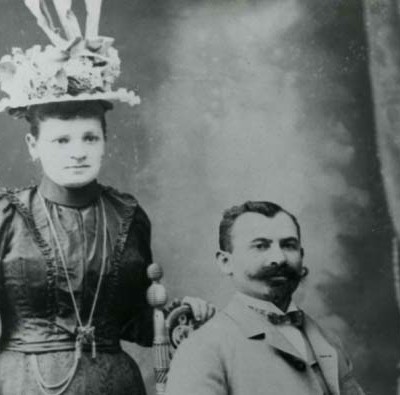
Solomon and Anna Dickstein Turetsky Rosenberg immigrated to Philadelphia, Pa., from Austria-Hungary about 1890. They had three children together, and Solomon had three from a previous marriage. The family moved to Erie, Pa., where Solomon was a tailor of fine clothing for women, before coming to Pittsburgh in 1907. They initially lived on North Craig Street in Oakland, then moved to the lower Hill District.
When Samuel Rosenberg (1896-1972), the fifth of the six children, showed an early aptitude for art, his mother enrolled him in classes at the Columbian Council School, the forerunner of the Irene Kaufmann Settlement. Rosenberg later took private lessons from Jacob R. Coblens, a Paris-trained painter working in Pittsburgh who provided an historical survey of Old Masters and encouraged his student to draw from memory. These methods became the foundation for Rosenberg’s later approach to art and teaching.
After a year at the National Academy of Design in New York, Rosenberg returned to Pittsburgh. His work was interrupted by a tour of duty in the U.S. Army during World War I. After his return, he soon established himself as a professional artist. He exhibited his work in the Carnegie International for the first time in 1920. Early on, he painted portraits, including one of Sol Rosenbloom. Starting in the 1930s, he began painting scenes of joy, hardship and daily life in the Hill District. The events of World War II inspired him to paint allegorical scenes, many using Jewish symbols. By the 1950s, he was working primarily in the abstract mode, focusing on the interplay of light, color and shape. During this period, according to his wife, Libbie Rosenberg, he said, “Now, now at last I am beginning to understand. I am just now hitting my stride; I have perfected my craft and it does not stand in my way. I have so many ideas, I can’t wait to get them onto canvas.”
Rosenberg was admired as an artist and beloved as a teacher. He founded the Neighborhood Art School at the Irene Kaufmann Settlement in 1917 and was best known for his long tenure at three institutions. He taught at the Carnegie Institute of Technology (now Carnegie Mellon University) from 1924 until 1965; taught adult classes at the Young Men and Women’s Hebrew Association from 1926 to 1964; and directed the art department at the Pennsylvania College for Women, now Chatham University, from 1937 to 1945.
Rosenberg was known for giving students great latitude in pursuing their individual interests as artists, as was seen by the wide array of styles on display in A Painter’s Legacy, a 2009 exhibit of work by his students at the American Jewish Museum at the Jewish Community Center of Greater Pittsburgh. His students included Mel Bochner, Philip Pearlstein and Andy Warhol, as well as Lois Katz Blaufeld, Rochelle Blumenfeld, Aaronel deRoy Gruber, Jane Haskell, Virginia Holzman, Anita Freund Morganstern and Abe Weiner. Rosenberg was a contemporary of Sybil Barsky.
While visiting the Hill District library as a young man, Rosenberg noticed Libbie Levin (1898-1987), one of the clerks. He purposefully lost several library cards in the hopes of striking up a conversation. Although the scheme failed, Rosenberg and Levin met later under different circumstances and married. They lived in Oakland for a time before moving to Mt. Royal Road in Squirrel Hill. They had one child, Dr. Murray Z. Rosenberg (1925-1996), who practiced medicine in Connecticut before retiring to North Carolina. Murray was also an artist in his own right, doing mostly illustrations.
Samuel and Libbie Rosenberg were a team. She handled the administrative side of his career, tracking his paintings as they were sold and compiling news clippings pertaining to his career. Their son, Murray, and daughter-in-law, Arline Levinson Rosenberg, later assumed these responsibilities. Since Rosenberg’s death, his niece, Ruth Westerman, has organized several symposia and exhibitions of his life and work. She was the executive producer of Samuel Rosenberg: Pittsburgh’s Painter Laureate, a 2008 film about Rosenberg directed by Kenneth Love. In 2003, Barbara Jones curated a comprehensive retrospective at the Westmoreland Museum of American Art and wrote a corresponding critical biography, both titled Samuel Rosenberg: Portrait of a Painter.